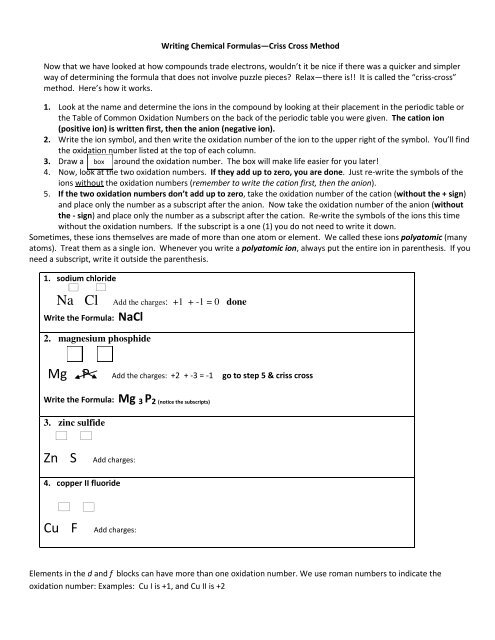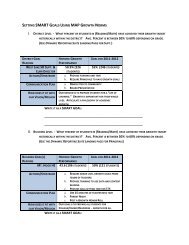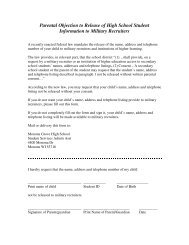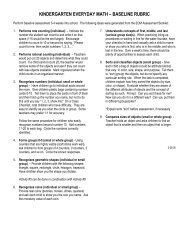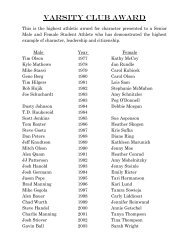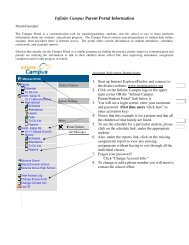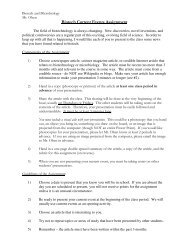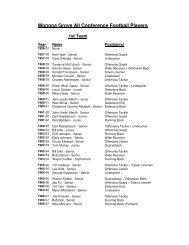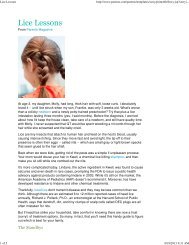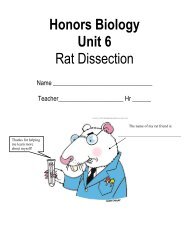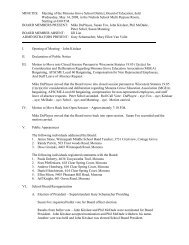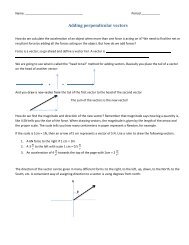Packet for Cu lab, naming and writing formulas, reaction types and ...
Packet for Cu lab, naming and writing formulas, reaction types and ...
Packet for Cu lab, naming and writing formulas, reaction types and ...
You also want an ePaper? Increase the reach of your titles
YUMPU automatically turns print PDFs into web optimized ePapers that Google loves.
Writing Chemical Formulas—Criss Cross Method<br />
Now that we have looked at how compounds trade electrons, wouldn’t it be nice if there was a quicker <strong>and</strong> simpler<br />
way of determining the <strong>for</strong>mula that does not involve puzzle pieces? Relax—there is!! It is called the “criss-cross”<br />
method. Here’s how it works.<br />
1. Look at the name <strong>and</strong> determine the ions in the compound by looking at their placement in the periodic table or<br />
the Table of Common Oxidation Numbers on the back of the periodic table you were given. The cation ion<br />
(positive ion) is written first, then the anion (negative ion).<br />
2. Write the ion symbol, <strong>and</strong> then write the oxidation number of the ion to the upper right of the symbol. You’ll find<br />
the oxidation number listed at the top of each column.<br />
3. Draw a box around the oxidation number. The box will make life easier <strong>for</strong> you later!<br />
4. Now, look at the two oxidation numbers. If they add up to zero, you are done. Just re-write the symbols of the<br />
ions without the oxidation numbers (remember to write the cation first, then the anion).<br />
5. If the two oxidation numbers don’t add up to zero, take the oxidation number of the cation (without the + sign)<br />
<strong>and</strong> place only the number as a subscript after the anion. Now take the oxidation number of the anion (without<br />
the - sign) <strong>and</strong> place only the number as a subscript after the cation. Re-write the symbols of the ions this time<br />
without the oxidation numbers. If the subscript is a one (1) you do not need to write it down.<br />
Sometimes, these ions themselves are made of more than one atom or element. We called these ions polyatomic (many<br />
atoms). Treat them as a single ion. Whenever you write a polyatomic ion, always put the entire ion in parenthesis. If you<br />
need a subscript, write it outside the parenthesis.<br />
1. sodium chloride<br />
Na Cl Add the charges: +1 + -1 = 0 done<br />
Write the Formula: NaCl<br />
2. magnesium phosphide<br />
Mg P Add the charges: +2 + -3 = -1 go to step 5 & criss cross<br />
Write the Formula: Mg 3 P 2 (notice the subscripts)<br />
3. zinc sulfide<br />
Zn S Add charges:<br />
4. copper II fluoride<br />
<strong>Cu</strong> F Add charges:<br />
Elements in the d <strong>and</strong> f blocks can have more than one oxidation number. We use roman numbers to indicate the<br />
oxidation number: Examples: <strong>Cu</strong> I is +1, <strong>and</strong> <strong>Cu</strong> II is +2


